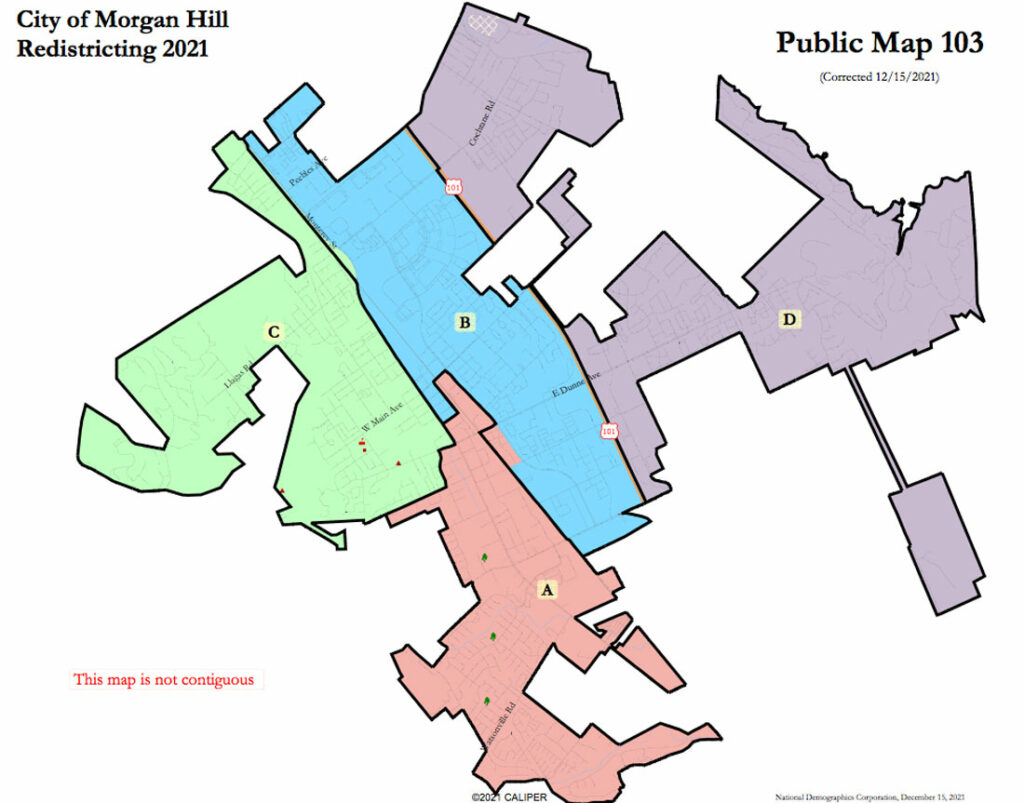After the Morgan Hill City Council spent months in public discussions and soliciting input from residents and redistricting experts, the courts are likely going to decide which boundaries will apply in local elections for the next 10 years.
Former Mayor Steve Tate is one of four plaintiffs who filed a lawsuit April 11 in Santa Clara County Superior Court against the City of Morgan Hill, including the city council. The lawsuit alleges that the new district map—known as “Map 103”—that was approved by the council in March is not in compliance with the California Fair Maps Act.
Also filing the lawsuit are Swanee Edwards and Brian and Kathy Sullivan. They are represented by attorney Christopher Skinnell of the Nielsen Merksamer firm.
“Despite the plain, unambiguous requirement of (the Fair Maps Act) that ‘to the extent practicable, council districts shall be geographically contiguous,’ the council adopted a district map that is not geographically contiguous to the extent practicable,” reads the lawsuit. “In so doing, it has disregarded the explicit advice of the city attorney, the city’s special redistricting counsel, the city’s redistricting consultant and many others.”
City Attorney Don Larkin advised the council numerous times prior to the lawsuit filing that Map 103 might be in violation of the state law, and warned that its approval would invite litigation.
At issue is District D of Map 103, which consists of two regions in east Morgan Hill that are separated by a patch of unincorporated county land. Geographical contiguity is the first of six priorities—listed in order of importance—listed for the drawing of elective districts in the Fair Maps Act.
The council approved Map 103 at the March 2 meeting on a 3-2 vote. Councilmembers John McKay and Gino Borgioli voted against the map.
Shortly after that meeting, Skinnell sent the council a demand letter on behalf of Tate and the other plaintiffs, urging them to “reconsider” their approval of Map 103. The council did so at the April 6 meeting, where the body again voted 3-2 to uphold its choice of Map 103.
The deadline for the city to adopt a district map is April 17. Larkin said at the April 6 meeting that if the court were to find Map 103 illegal, the judge would likely select Morgan Hill’s new city council district map.
Larkin also noted that the court would likely expedite the case in the event of the lawsuit, as it is related to a pressing election matter.
Two council members—Yvonne Martinez Beltran of District B and McKay of District D—are up for reelection in November. Martinez Beltran has been a steadfast vocal supporter of Map 103, which leaves the current council districts mostly intact.
Cities with elective council districts—as well as other government bodies—are required by state and federal law to review their boundaries every 10 years based on changes in population and demographics presented in the U.S. Census.
The city’s current council district map is its first ever, created in 2017 after another attorney threatened a lawsuit based on the California Voting Rights Act.
The state legislature passed the Fair Maps Act a couple years after the Morgan Hill council adopted its current district map.
Morgan Hill attorney Armando Benavides—another vocal proponent of Map 103—had threatened to sue the city if the council rejected Map 103.
Borgioli said April 6 that his decision was based on which of the competing lawsuit threats is likely to do more harm to the city. He supported a different district map known as the “NDC Green Map,” which was one of about half a dozen drafts the council considered for adoption.
“I can’t disregard the order of priority just because of what we’ve heard tonight,” Borgioli said. “Map 103 is not legal according to the Fair Maps Act. We may not like that law but that’s the law in front of us.”









